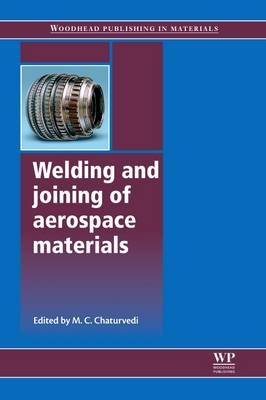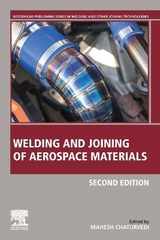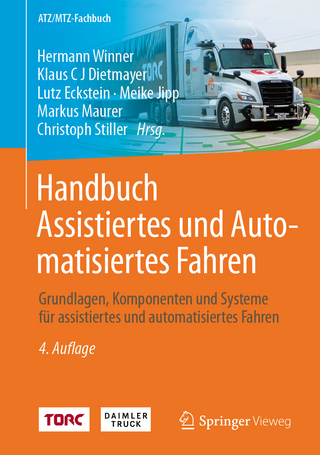
Welding and Joining of Aerospace Materials
Woodhead Publishing Ltd (Verlag)
978-1-84569-532-3 (ISBN)
- Titel erscheint in neuer Auflage
- Artikel merken
Welding and joining techniques play an essential role in both the manufacture and in-service repair of aerospace structures and components, and these techniques become more advanced as new, complex materials are developed. Welding and joining of aerospace materials provides an in-depth review of different techniques for joining metallic and non-metallic aerospace materials.
Part one opens with a chapter on recently developed welding techniques for aerospace materials. The next few chapters focus on different types of welding such as inertia friction, laser and hybrid laser-arc welding. The final chapter in part one discusses the important issue of heat affected zone cracking in welded superalloys. Part two covers other joining techniques, including chapters on riveting, composite-to-metal bonding, diffusion bonding and recent improvements in bonding metals. Part two concludes with a chapter focusing on the use of high-temperature brazing in aerospace engineering. Finally, an appendix to the book covers the important issue of linear friction welding.
With its distinguished editor and international team of contributors, Welding and joining of aerospace materials is an essential reference for engineers and designers in the aerospace, materials and welding and joining industries, as well as companies and other organisations operating in these sectors and all those with an academic research interest in the subject.
Mahesh C. Chaturvedi is Professor Emeritus in the Department of Mechanical and Manufacturing Engineering at the University of Manitoba, Canada.
Contributor contact details
Preface
Part I: Welding techniques
Chapter 1: New welding techniques for aerospace engineering
Abstract:
1.1 Introduction
1.2 Airworthiness implications of new welding and joining technologies
1.3 New developments in welding and joining of aerospace materials
1.4 Failure of welded and bonded joints in service
1.5 The importance of international standards
Chapter 2: Inertia friction welding (IFW) for aerospace applications
Abstract:
2.1 Introduction
2.2 Process parameters, heat generation and modelling
2.3 Microstructural development
2.4 Development of mechanical properties
2.5 Residual stress development
2.6 Future trends
2.7 Source of further information and advice
Chapter 3: Laser welding of metals for aerospace and other applications
Abstract:
3.1 Introduction
3.2 Operating principles and components of laser sources – an overview
3.3 Key characteristics of laser light
3.4 Basic phenomena of laser light interaction with metals
3.5 Laser welding fundamentals
3.6 Laser weldability of titanium alloys
3.7 Future trends
3.8 Sources of further information and advice
Chapter 4: Hybrid laser-arc welding of aerospace and other materials
Abstract:
4.1 Introduction
4.2 Fundamentals of hybrid laser-arc welding
4.3 Hybrid laser-arc welding of aeronautical materials
4.4 Future trends
Chapter 5: Heat-affected zone cracking in welded nickel superalloys
Abstract:
5.1 Introduction
5.2 Characteristics of crack-inducing intergranular liquid and factors that affect heat-affected zone (HAZ) cracking
5.3 Formation of HAZ grain-boundary liquid
5.4 Constitutional liquation of second-phase particles in nickel-based superalloys
5.5 Role of minor elements in HAZ intergranular liquation cracking
5.6 Conclusions
Part II: Other joining techniques
Chapter 6: Assessing the riveting process and the quality of riveted joints in aerospace and other applications
Abstract:
6.1 Introduction
6.2 Riveting process and quality assessment of the rivet installation
6.3 Determination of residual strains and interference in riveted lap joints
6.4 Summary and recommendations for the riveting process research
6.5 Case studies using the force-controlled riveting method
6.6 Conclusions
6.7 Acknowledgements
Chapter 7: Quality control and non-destructive testing of self-piercing riveted joints in aerospace and other applications
Abstract:
7.1 Introduction
7.2 Computer vision
7.3 Ultrasonic testing
7.4 Conclusion
Chapter 8: Improvements in bonding metals for aerospace and other applications
Abstract:
8.1 Introduction: key problems in metal bonding
8.2 Developments in the range of adhesives for metal
8.3 Developments in surface treatment techniques for metal
8.4 Developments in joint design
8.5 Developments in modelling and testing the effectiveness of adhesive-bonded metal joints
8.6 Future trends
8.7 Sources of further information and advice
Chapter 9: Composite to metal bonding in aerospace and other applications
Abstract:
9.1 Introduction
9.2 Testing of adhesive bonded structures
9.3 Bonding to the metal substrate
9.4 Composite pre-treatment
9.5 Bonding composite to metal
9.6 Adhesives
9.7 Composite–metal bonded structures
9.8 Conclusions
9.9 Acknowledgements
Chapter 10: Diffusion bonding of metal alloys in aerospace and other applications
Abstract:
10.1 Introduction
10.2 Diffusion-bonding process
10.3 Conclusions and future trends
Chapter 11: High-temperature brazing in aerospace engineering
Abstract:
11.1 Introduction
11.2 Filler metals
11.3 Trends in brazing at high temperature
11.4 Conclusion and future trends
Appendix: Linear friction welding in aerospace engineering
Index
| Erscheint lt. Verlag | 19.12.2011 |
|---|---|
| Reihe/Serie | Woodhead Publishing Series in Welding and Other Joining Technologies |
| Verlagsort | Cambridge |
| Sprache | englisch |
| Maße | 156 x 234 mm |
| Gewicht | 840 g |
| Themenwelt | Technik ► Fahrzeugbau / Schiffbau |
| Technik ► Luft- / Raumfahrttechnik | |
| Technik ► Maschinenbau | |
| ISBN-10 | 1-84569-532-1 / 1845695321 |
| ISBN-13 | 978-1-84569-532-3 / 9781845695323 |
| Zustand | Neuware |
| Haben Sie eine Frage zum Produkt? |
aus dem Bereich



